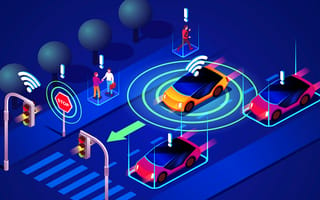Vehicle-to-everything (V2X) technology uses sensors, cameras and wireless connectivity so cars can connect to and communicate with their drivers and surroundings.
While cars have always communicated with drivers in rudimentary ways — like when a needle points to an orange “E” if gas is low, or an interior light stays on if you accidentally leave a door open — the promise of V2X tech is that cars will be able to essentially talk to pedestrians and bicyclists, traffic signals and road signs, and cities and municipalities, creating a link between cars and their surroundings that makes roads easier and safer to travel on.
What Is Vehicle-to-Everything (V2X) Technology?
What Is Vehicle-to-Everything (V2X) Technology?
Vehicle-to-everything technology consists of the sensors, cameras and wireless connectivity — like WiFi, radio frequencies and LTE and 5G cellular technology — that would allow cars to share information with each other, their drivers and their surroundings.
Currently, V2X technology is very piecemeal. While sensors, cameras and networks all exist, they’re not really working together to link cars with one another or their surroundings to make driving safer. Many cars on the road today don’t have the capability to send and receive data to one another unless they’re the same model. And large-scale networks like LTE and 5G, which would effectively bridge the gap between vehicles, infrastructure and pedestrians, so they could actually communicate, haven’t been fully adopted in the auto industry yet. In order for V2X to work at its full potential, it has to be widespread.
“Connectivity is really the Holy Grail.”
“Typically, you have all this technology, but if it can’t communicate reliably, it’s hard to make the application work,” Todd Rigby, director of sales at Rajant, a mobile network infrastructure company, told Built In.
Using wireless mesh networks to manage and maintain broadband connectivity, Rajant connects vehicles to one another and to infrastructure for use in mining, construction and logistics, specifically freight applications.
“Connectivity is really the Holy Grail,” Rigby said. “Can you maintain continuous connectivity? And over what ranges? And can you have reasonably consistent throughput?”
While some cars use radar, LiDAR and other sensing technology to warn drivers when they get too close to the car ahead of them, or if they may hit something when they’re backing up, few have the ability to talk to one another. The hope is that one day, new cars on the road will not only be able to reliably relay information back and forth, but that they’ll also be able to communicate with traffic signals, pedestrians, bicyclists and city-wide networks. By bridging this communication gap, roadways may become less dangerous.
According to Rigby, the technology will have substantial advantages over using radar and LiDAR exclusively, as it allows drivers to factor in not only what their own car sensors are observing but also what cars around them are likely to do in response to unexpected obstacles.
In Vehicle-to-Everything Technology, What Exactly Does “Everything” Mean?
There are several components that work together to create the end-to-end communication that V2X demands.
V2V: Vehicle to Vehicle
Vehicle to vehicle, or V2V, communication is when cars are able to exchange data on speed, location and direction with each other. This exchange happens wirelessly and in real-time. Many cars are equipped with this kind of technology already, which can be seen through features like lane-change assistance and blind-spot detection.
V2I: Vehicle to Infrastructure
Vehicle to infrastructure, also known as V2I, is when cars are able to wireless share information between themselves and connected road infrastructure like smart traffic lights or road signs.
V2P: Vehicle to Pedestrian
Vehicle to pedestrian, or V2P, communication is when a car is able to sense nearby pedestrians (this includes bicyclists, strollers and wheelchairs).
V2N: Vehicle to Network
Vehicle to network, or V2N, communication refers to when cars are able to exchange data within network systems like LTE and 5G.
V2X: Vehicle to Vehicle, Infrastructure, Pedestrian and Network
Vehicle to everything — V2X — technology is when a car is able to recognize and communicate with all of these facets of transportation. Cars designed with V2X in mind serve as prime examples of connected vehicle technology.
Advantages of V2X
Benefits of Vehicle to Everything Tecnology
- Improves safety for drivers and pedestrians.
- Allows for more fuel efficiency.
- Saves time and money.
Improves Safety
The National Highway Traffic Safety Administration (NHTSA) estimates that nearly 43,000 people died in car accidents in 2021 in the United States. But V2X technology may be able to help combat these numbers.
“There are so many accidents today that could be prevented,” Maite Bezerra, an automotive industry analyst told the New York Times. “And with advanced warnings of traffic jams and red lights reducing sudden braking, fuel efficiency will also be improved.”
NHTSA estimates that even adopting only two V2X safety features, like LiDAR and radio communication between cars, could save 1,000 lives and prevent half a million crashes per year.
Creates More FUEL-EFFICIENT Vehicles
With V2X, cars are able to collect data on traffic jams, stop lights and speed zones. Then the car is able to translate this data into a route that increases fuel efficiency and avoids unnecessary stopping. In the case of electric cars, V2X connects with infrastructure to alert drivers where nearby charging stations are located.
Saves Time and Money
Since a car with V2X technology can be more fuel efficient, this also means it can save drivers time and money. Connected vehicle technology can suggest faster driving routes and help avoid incidents on the road. This can help drivers save money on gas and repairs in the long run.
Issues With V2X
Unreliable Sensors
For V2X to increase safety, vehicles, infrastructure, pedestrians and cities will need to be equipped with sensors — and they’ll have to be reliable.
According to Miles Flamenbaum, CEO of Actasys, a company that specializes in maintaining sensor functionality and works with car manufacturers like Volvo, sensors don’t come without their issues.
“If that sensor isn’t properly prepared for adverse weather conditions or adverse operating conditions where it can widely operate without losing data then you have a challenge,” Flamenbaum told Built In. “You end up with data that ultimately, under certain conditions, isn’t trustworthy.”
And this sensor data is key to V2X functionality — it’s also critical to the future of autonomous and self-driving vehicles — but according to Flamenbaum, what appears to still be missing is coordination of data streams between both the vehicles and the surrounding infrastructure.
“Coordinating the infrastructure with the vehicle, we know it’s coming,” Flamenbaum said. “We hear our customers talk about increasing that capability in the vehicle to connect to infrastructure. And I think that’s going to be your next hurdle.”
Vulnerable Data
Like any technology where hordes of data is gathered and stored, there’s always going to be a risk that hackers will find a way inside V2X systems to steal that information or even hold the network hostage. And then there’s just the general privacy concerns related to car companies, or municipalities, or those managing the infrastructure having access to your driving data and driving habits, even if safety and efficiency are improved.
But while privacy and security are valid concerns — and drivers will navigate them just like they do in almost every other data-driven industry — the immediate future of V2X really centers on two things: the regulatory landscape and consumers.
Regulatory Hurdles
The biggest issue with V2X technology right now may be on the regulatory side.
In 2022, a circuit court judge sided with the Federal Communications Commission, after the agency, in 2020, reclaimed some of the radio spectrum originally allocated in 1999 for use by “intelligent transportation systems,” like V2V and V2X technologies, to meet the spectrum demands of Wi-Fi routers and other devices. Though the FCC argued that more than enough megahertz for safety-related functions was still available, the automotive industry wasn’t happy and sought to stop it claiming that the FCC’s action was “arbitrary and capricious.” The judge disagreed and dismissed the claim.
“The problem, as hilariously put by Judge Justin Walker in his opinion, is that this technology has never really existed,” The Verge’s Andrew J. Hawkins wrote when reporting on the court’s decision. “It was one of those ‘just around the corner’-type innovations that has always been promised but never actually delivered. It was a fantasy, and today, the court’s basically said as much.”
Lack of Consumer Awareness
But debates between the government and the automotive industry aside, it’s likely consumers who will have the final say when it comes to their cars’ connection to everything.
People are not really considering whether a car can communicate with its surroundings when shopping for a new car, according to Grant Feek, CEO of TRED, an online car marketplace.
Buyers are usually thinking about acceleration or handling, maybe even style and the status a car evokes, or they take a more practical approach, looking for a good deal, good mileage and safety, Feek told Built In.
“Most drivers probably fall somewhere in between those two ends of the spectrum, and tend to value safety and fuel efficiency, as well as enough technology and features to provide comfort and convenience in day-to-day use,” Feek said. “Given current interest rates, and generally higher car prices, most car buyers are also more mindful of cost than they might have previously been.”
“Those who are ultra technology-oriented probably know what [V2X] is, and it may affect their purchasing decisions, but my sense is that most people aren’t yet familiar with it.”
Cost could become one of many barriers to greater adoption. If V2X is paired with an upcharge, Feek believes consumers may not be convinced of its value unless car companies can clearly and effectively market the benefits. There’s also the potential for hackers to tap into V2X systems and privacy concerns drivers may have related to the monitoring and sharing of their driving routes and habits, Feek said.
But the primary barrier in Feek’s eyes is that most drivers don’t know V2X technology even exists. (Only a few cars like the 2017 Mercedes E-Class and Cadillac’s CTS sedans are equipped with vehicle-to-vehicle and vehicle-to-infrastructure capabilities.)
“Those who are ultra technology-oriented probably know what [V2X] is, and it may affect their purchasing decisions, but my sense is that most people aren’t yet familiar with it,” Feek said.
But he’s confident that drivers will someday want what V2X technology has to offer, especially when it comes to capabilities around traffic-aware route optimization and hazard avoidance. But not without a lot of stars aligning first.
“In the future, V2X likely will be a compelling feature that car buyers will want, if it becomes widely supported by municipalities and vendors who can make it useful and relevant through supporting infrastructure and real-world benefits,” Feek said.
V2X Companies to Know
Qualcomm, a global connectivity and semiconductor company, offers both software and hardware solutions for V2X. Its C-V2X 9150 chip is compatible with 5G networking and ADAS sensors. The company has also modified its Snapdragon platform to facilitate vehicle to vehicle communication.
Well known automakers like Ford are taking advantage of V2X technology too. The company began integrating V2X in its vehicles made in China in 2021. China’s embrace of 5G and Ford’s membership in the 5G Automobile Association allow for key testing of V2X technology as well as multi-access edge computing in its vehicles.
Cohda Wireless offers hardware and software for the growing V2X industry. Its variety of V2X products are geared towards enhancing GNSS positioning in remote areas and parking garages, data capture over increased distances and improving radio communication between cars when weather conditions might impede cameras and sensors.






